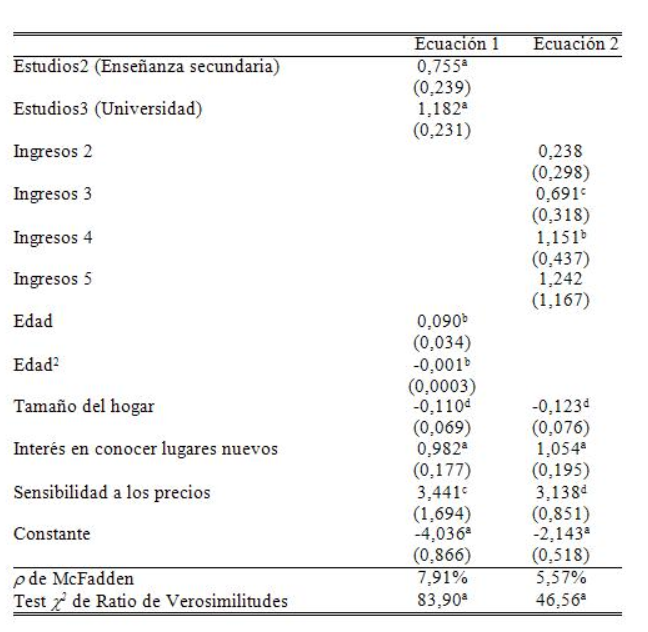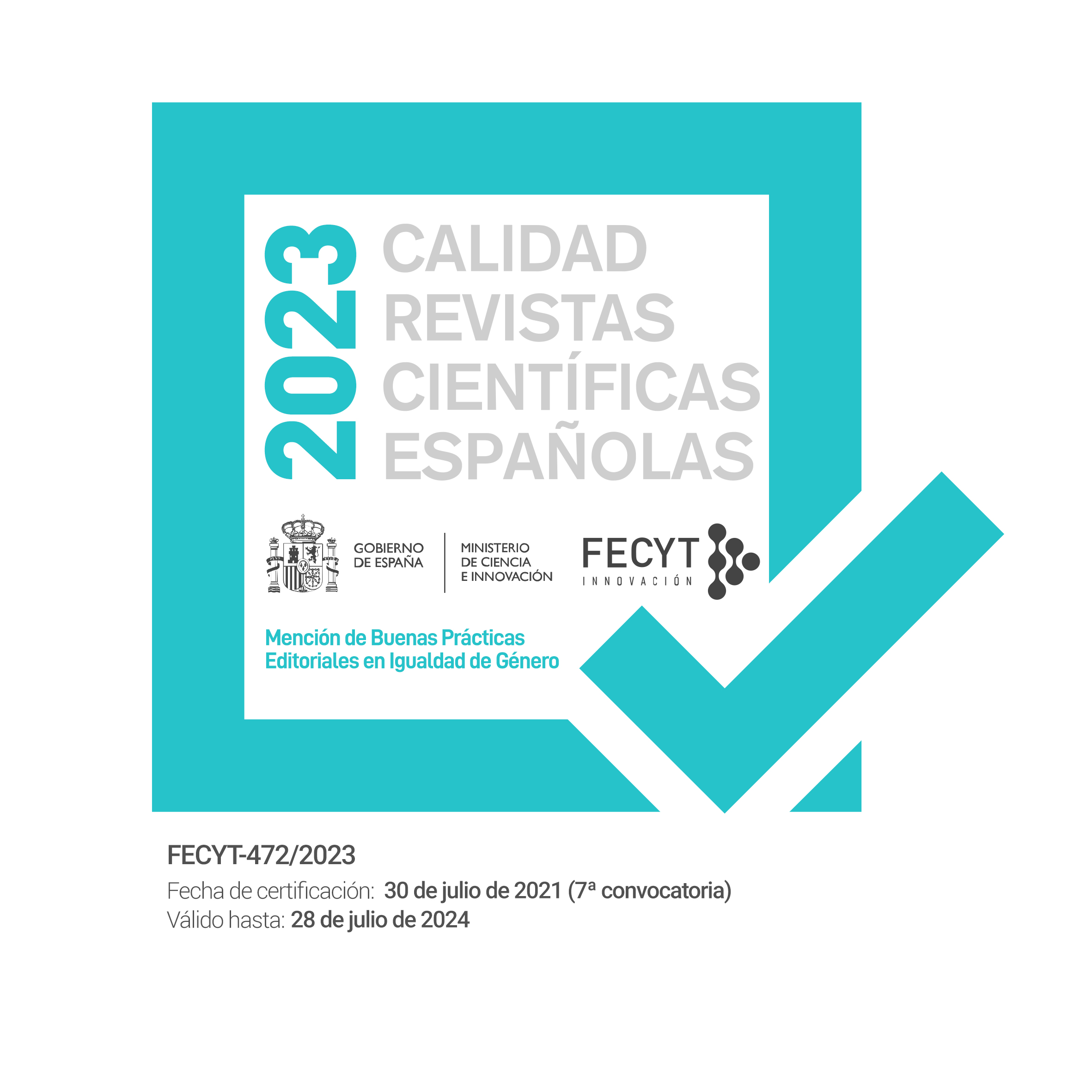Determinants of cultural motivation in destination choice
Keywords:
Cultural tourism, Tourist choice behaviour, Probabilistic choice modelsAbstract
The objective of this article is to analyse the determinants of tourists’ cultural motivation when choosing a destination. To this end, several research hypotheses are proposed regarding socio-demographics, psychographics and tourist behaviour. The empirical application carried out on a national sample of 2.127 individuals allows us to conclude that higher educational levels, smaller household sizes, greater interest in knowing new places and less price sensitivity bring about greater cultural motivation. Especially conspicuous is the curvilinear effect obtained for the variable age: initially increases and then, after a point, it starts decreasing. Considering the importance of these dimensions, managerial implications for cultural destinations are straightforward.
Downloads
References
AMAYA, Santiago.; VELASCO, Laura.; SANTIAGO, Irene. (2007) “La protección del patrimonio cultural: ordenación del territorio y gestión del patrimonio en la Alpujarra media granadina”. Revista Electrónica de Patrimonio Histórico. Granada, nº 1.
ANDERSON, John. (1970). The Ulysses Factor. Nueva York. Ed. Harcourt Brace Johanovich, Inc.
ASHOK, Kalidas.; DILLON William.; YUAN, Sophy. (2002), “Extending Discrete Choice Models to Incorporate Attitudinal and Other Latent Variables”. Journal of Marketing Research, nº 34, pp. 31-46.
BEN-AKIVA, Mushe.; LERMAN, Stevan. (1985). Discrete Choice Models: Theory and Application to Travel Demand. Cambridge MIT Press.
BIGNÉ, Enrique.; FONT, Xavier.; ANDREU, Luisa. (2000). Marketing de Destinos Turísticos: Análisis y Estrategias de Desarrollo. Madrid: Esic.
CARROLL, Archie. (2000) “Ethical Challenges for Business in the New Millennium: Corporate Social Responsibility and Models of Management Morality”. Business Ethics Quarterly 10, pp. 33-42.
CASTILLO RUIZ, José. (2007) “El futuro del patrimonio histórico: la patrimonialización del hombre”. Revista Electrónica de Patrimonio Histórico. Granada, nº 1.
CIS Centro de Investigaciones Sociológica. (1995). Estudio 2.193,
COLLINS, Darriam.; TISDELL, Clem. (2002). “Aged-Related Lifecycles: Purpose Variations”. Annals of Tourism Research, 29, 3, pp. 801-818.
CRAWFORD, Duane.; GODBEY, Geoffrey. (1987). “Reconceptualizing Barriers to Family Leisure”. Leisure Sciences, 9, pp.119-128.
DALEN, Erik. (1989). “Research into Values and Consumer Trends in Norway”. Tourism Management, 10, pp. 183-186.
DAVIS, Brian.; MANGAN, Jean. (1992). “Family Expenditure on Hotels and Holiday.” Annals of Tourism Research, 19, pp. 691-699.
DE BORJA, Luis.; CASANOVAS, Josep.; BOSCH, Ramón. (2002). El Consumidor Turístico. Madrid: Esic Editorial.
DUBIN, J.A. (1995). “Estimating Logit Models with Spatial Dependence” in Anselin, L. & Flora, R.J.G.M., eds., New Directions in Spatial Econometrics. Berlin: Springer.
EXCELTUR (2007). Perspectivas Turísticas. Balance 2006 y tendencias para 2007. Madrid: Exceltur.
EXPANSIÓN (2004) La Responsabilidad Social es Rentable, 19 de marzo. EYMANN, Angelika.; RONNING, Gerd. (1992). “Discrete Choice Analysis of Foreign Travel Demand” en Vosgerau, H.J., ed. European Integration in the World Economy. Studies in International Economics and Institutions. Berlin: Springer.
EYMANN, Angelika.; RONNING, Gerd. (1997). “Microeconometric Models of Tourists’ Destination Choice”. Regional Science and Urban Economics, 27, pp. 735-761.
FALCK, Oliver.; HEBLICH, Stephan. (2007). “Corporate Social Responsibility: Doing Well by Doing Good”. Business Horizons, 50, pp. 247-254.
FAMILITUR (1999). Movimientos Turísticos de los Españoles, Informe Anual. Madrid: Instituto de Estudios Turísticos.
FAMILITUR (2000). Movimientos Turísticos de los Españoles, Informe Anual. Madrid: Instituto de Estudios Turísticos.
FAMILITUR (2008). Movimientos Turísticos de los Españoles, Informe Anual. Madrid: Instituto de Estudios Turísticos.
FERNÁNDEZ, Víctor. (2008). “La protección del patrimonio mundial en España”, Revista Electrónica de Patrimonio Histórico. Granada, nº 2.
FESENMAIER, Daniel.; JENG, Jiann-Min. (2002). “Assessing Structure in the Pleasure Trip Planning Process”. Tourism Analysis, nº 5, pp. 13-27.
FIGUEROLA, Manuel (1990). Teoría Económica del Turismo. Madrid: Alianza Editorial.
FONT, Xavier.; HARRIS, Catherine. (2004). “Rethinking Standards from Green to Sustainable”. Annals of Tourism Research, nº 31, pp. 986-1007.
GACETA DE LOS NEGOCIOS (1999). Las hoteleras, seducidas por el patrocinio artístico y taurino, 20 septiembre
GONZÁLEZ, Ana María.; BELLO, Laurentino. (2002). “The constructy “Lifestyle” in market Segmentation: The Behavious of Tourist Consumers”. European Journal of
Marketing, 36, ½, pp. 51-85.
GONZÁLEZ, Ana maría.; DÍAZ, Ana María. (1996). “Análisis del Comportamiento del Turista a partir de las Variables de Estilos de Vida”, en Valdés, L. y Ruiz Vega, A., eds.,
Turismo y Promoción de Destinos Turísticos: Implicaciones Empresariales. Gijón: Universidad de Oviedo.
HAIDER, Wolfgang.; EWING, Gordon. (1990). “A Model of Tourist Choices of Hypothetical Caribbean Destinations”. Leisure Sciences, 12, pp. 33-47.
HAY, Mary.; McCONNELL, Kenneth. (1979). “An Analysis of Participation in Nonconsumptive Wildlife Recreation”. Land Economics, 55, 4, pp. 460-471.
HENDERSON, Joan. (2007). “Corporate Social Responsibility and Tourism: Hotel companies in Phuket, Thailand, after the Indian Ocean Tsunami”. International Journal of Hospitality Management, 26, pp. 228-239.
HENSHER, David.; JOHNSON, Lester. (1981). Applied Discrete-Choice Modelling. Nueva York: John Wiley & Sons, Inc.
HERNÁNDEZ, Francisca. (2007) “La museología ante los retos del siglo XXI”, Revista Electrónica de Patrimonio Histórico. Granada, nº 1.
HIGGINS-DESBIOLLES, Freya. (2006). “More than an “Industry”: The Forgotten Power of Tourism as a Social Force”, Tourism Management, 27, pp.1192-1208.
HSIEH, Sheasushing.; O’LEARLY, Joseph.; MORRISON, Alastair.; CHANG, Pao-Hung. S. (1993). “Modelling the Travel Mode Choice of Australian Outbound Travellers. The Journal
of Tourism Studies, 4, 1, pp. 51-61. IDEAS http://ideas.repec.org/a/iec/inveco/v32y2008i2p231-255.html, [11 de diciembre de 2009]
KAHNEMAN, Daniel.; TVERSKY, Amos. (1979). “Prospect theory: and analysis of decision under risk”. Econometrica, 47, 2, pp. 263-291.
KOTLER, Philip.; BOWEN, John.; MAKENS, James. (2004) Marketing para turismo.3ª Edición. Madrid: Prentice Hall.
LEHMANN, Donald. (1993). Investigación and Análisis de Mercado. México: Cecsa.
MADDALA, Gangadharrao. (1983). Limited-dependent and Qualitative Variables in Econometrics. New York: Cambridge University Press.
MARTÍN, Marcelo. (2007). “La difusión del patrimonio. Actualización y debate”, Revista Electrónica de Patrimonio Histórico. Granada, nº 1.
MARTIN, Marina.; MORAN, Dominic. (2007). “Impact of the FTSE4Good Index on Firm Price: An Event Study”. Journal of Environmental Mangement 82, pp. 529-537.
MAYO, Edward.; JARVIS, Lance. (1981). The Psychology of Leisure Travel, Boston: CBI Publishing Co.Maddala, G.S. (1983) Limited-dependent and Qualitative Variables in Econometrics. Nueva York: Cambridge University Press.
MIECZKOWSKI, Zbigniew. (1990). “World Trends in Tourism and Recreation”, en American University Studies Series XXV Geography, vol. 3. Nueva York: Peter Lang.
MILLER, John.; HAY, Michael. (1981). “Determinants of Hunter Participation: Duck Hunting in the Mississippi Flyway”, American Journal of Agricultural Economics, 63, pp. 677-684.
MORLEY, Clive. (1994). “Experimental Destination Choice Anaylsis”. Annals of Tourism Research, 21, 4, pp. 780-791.
MORLEY, Clive. (1994). “Discrete Choice analysis of the Impact of Tourism Prices”. Journal of Travel Research, pp. 8-14.
MOUTINHO, Louiz. (1987). “Consumer Behaviour in Tourism”. European Journal of Marketing, 21, 10, pp. 1-44.
MULLER, Thomas. (1991). “Using Personal Values to Define Segments in an International Tourism Market”. International Marketing Review, 8, pp. 57-70.
MUÑIZ, Ignacio. (2007). “El proyecto municipal del ecomuseo del río Caicena (Almedinilla-Córdoba): Patrimonio y desarrollo local desde el mundo rural. Revista Electrónica de Patrimonio Histórico. Granada, nº 1.
NICOLAU, Juan Luis. (2008). “Characterizing tourist sensitivity to distance”. Journal of Travel Research, 47, pp. 43-52
NICOLAU, Juan Luis. (2008). “Testing reference dependence, loss aversion and diminishing sensitivity in Spanish tourism”. Investigaciones Económicas, 32, pp. 231-255. Disponible en http://www.funep.es/invecon/sp/sArt_May2008.asp
PITTS, Robert.; WOODSIDE, Arc. (1980). “Personal Values and Travel Decisions”, Journal of Travel Resesarch, 25 (1980), pp. 20-25.
POST, James.; PRESTON, Lee.; SACHS, Sybille. (2002). Redefining the Corporation:
Stakeholder Management and Organizational Wealth. Stanford, CA: Stanford University Press.
ROBINS, Fred. (2005). “Why Corporate Social Responsibility Should Be Popularized but Not Imposed”, Proceedings of the European Academy of Management Conference. Munich.
SANTOS, José Luis. (1983). “La Decisión de Compra del Turista-Consumidor”. Estudios Turísticos, 79, pp. 39-53.
SCOTT LONG, John. (1997) Regression Models for Categorical and Limited Dependent Variables. California: Sage Publications.
SEDDIGHI, Hamid.; THEOCHAROUS, Antonis. (2002). “A Model of Toursim Destination Choice: A Theoretical an Empirical analysis”. Tourism Management, 23, 5, pp. 475-487.
SHIH, David. (1986). “VALS as a Tool of tourism Market Research: the Pennsylvania Experience”. Journal of Travel Research, 24, 4, pp. 2-11.
SIDERELIS, Christos.; MOORE, Roger. (1988). “Recreation Demand and the Influence of Site Preference Variables”. Journal of Leisure Research, 30, 3, pp. 301-318.
SMITH, Kerry.; MUNLEY, Vincent. (1978). “The Relative Performance of Various Estimators of Recreation Participation Equations”. Journal of Leisure Research, 10, 3, pp.165-176.
TRAIN, Kenneth. (1998). “Recreation Demand Models with Taste Differences over People”, Land Economics, 74, p. 2.
WALSH, Richard.; KUN, John.; MCKEAN, John.; HOF, John. (1992). “Effect of Price on Forecasts of Participation in Fish and Wildlife Recreation: An Aggregate Demand Model”. Journal of Leisure Research, 24, 2, pp. 140-156.
WELLS, William.; GUBAR, George. (1966). “The Life Cycle Concept in Marketing Resesarch”. Journal of Marketing Research, 3, pp. 355-363.
YAMAN, Ruhi.; GUREL, Eda. (2006). “Ethical ideologies of tourism marketers”. Annals of Tourism Research, 33, pp. 470-489.
ZINS, Andreas. (1996). “Psychographic Tools in Tourism Behaviour Models: A Cross Validation”, Conference of the European Marketing Academy-EMAC, 1291-1311.

Downloads
Published
How to Cite
Issue
Section
License
Las/os autoras/es conservan los derechos de autoría y otorgan a la revista el derecho de primera publicación (reproducción, edición, distribución, comunicación pública y exhibición).
Más infomación en Sobre la revista > Aviso de derechos de autor/a










